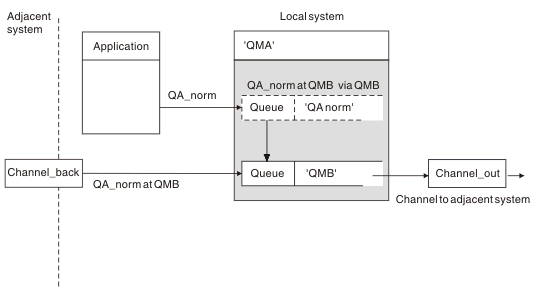Putting messages on remote queues
In a distributed-queuing environment, a transmission queue and channel are the focal point for all messages to a location whether the messages originate from applications in your local system, or arrive through channels from an adjacent system. This is shown in Figure 1 where an application is placing messages on a logical queue named ‘QA_norm’. The name resolution uses the remote queue definition ‘QA_norm’ to select the transmission queue ‘QMB’, and adds a transmission header to the messages stating ‘QA_norm at QMB’.
Messages arriving from the adjacent system on ‘Channel_back’ have a transmission header with the physical queue name ‘QA_norm at QMB’, for example. These messages are placed unchanged on transmission queue QMB.
The channel moves the messages to an adjacent queue manager.
Figure 1. A remote queue definition is used to resolve a queue name to a transmission queue to an adjacent queue manager. Note: The dashed outline represents a remote queue definition. This is not a real queue, but a name alias that is controlled as though it were a real queue.
If you are the WebSphere MQ system administrator, :
- Define the message channel from the adjacent system
- Define the message channel to the adjacent system
- Create the transmission queue ‘QMB’
- Define the remote queue object ‘QA_norm’ to resolve the queue name used by applications to the desired destination queue name, destination queue manager name, and transmission queue name
In a clustering environment, you only need to define a cluster-receiver channel at the local queue manager. You do not need to define a transmission queue or a remote queue object. For information about this, see the WebSphere MQ Queue Manager Clusters book.
Parent topic:
WebSphere MQ distributed-messaging techniques
ic10810_
Home
